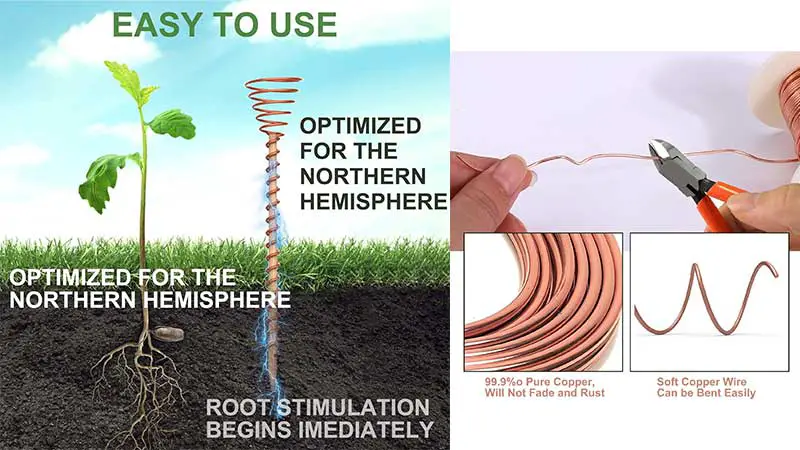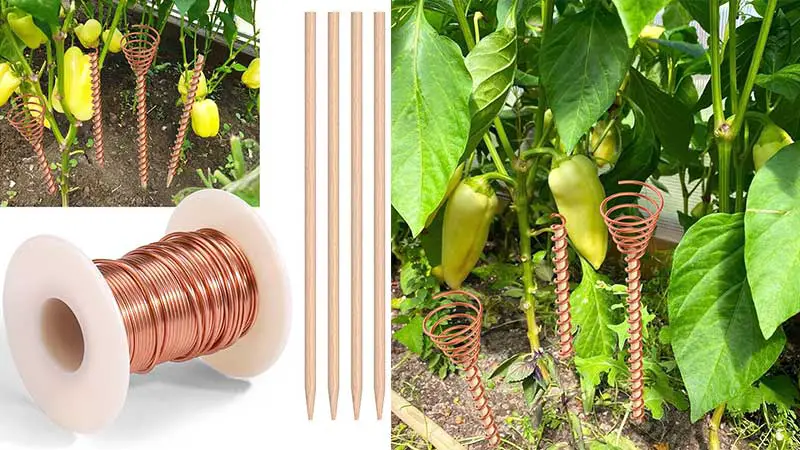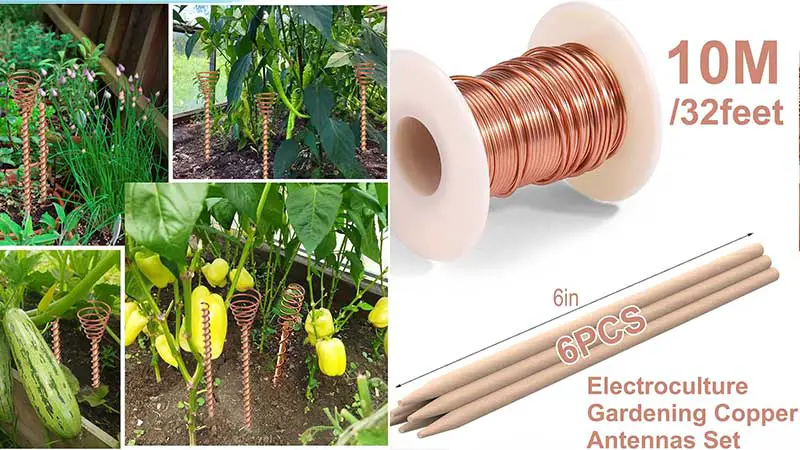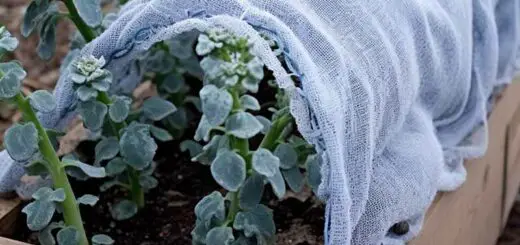Copper Wire for the Garden: With Pictures
Copper wire is used in gardening to deter pests and promote plant growth. Placing copper wiring around plants or in the soil can create an electric charge that deters slugs, snails, and other small pests from feeding on the plants.
Buy Copper Wire from Amazon Top Rated Seller
This gardening tool can also create trellises, plant supports, and other structures that help plants grow and thrive.
It can also create a natural-looking patina that adds aesthetic value to garden sculptures or other decorative features.
As a participant in the Amazon Services LLC Associates Program, an affiliate advertising program designed to provide a means for us to earn fees by linking to Amazon.com and affiliated sites, at no additional cost to you.
Amazon Affiliate Disclosure
Buy Copper Wire from Amazon Top Rated Seller
Copper Wire for the Garden: With Pictures
Copper wire can be a useful and somewhat unconventional tool in gardening. Here are some key points that gardeners might not commonly know about using copper wire in their gardens:
- Slug and Snail Deterrent: Copper wire can act as a natural deterrent for slugs and snails. When these pests come into contact with copper, it causes a reaction that they find unpleasant, effectively keeping them away from plants. Wrapping copper wire around the base of plants or planters can help protect them from slug and snail damage.
- Tree Trunk Protection: Wrapping copper wire around the trunk of a tree can prevent damages caused by rodents and other small animals. The wire acts as a physical barrier, discouraging animals from chewing or clawing at the bark.
- Support for Climbing Plants: Copper wire can be used to create supports for climbing plants. Its flexibility allows it to be shaped into various forms, such as trellises or frames. However, it’s important to ensure that the wire is not too tight around the plant to avoid restricting growth.
- Conductivity and Plant Growth: Some studies suggest that the electromagnetic fields generated by copper can positively affect plant growth. While the exact mechanism is not fully understood, it’s believed that the copper wire may influence the energy balance in plants, potentially promoting healthier growth.
- Copper Toxicity: It’s important to note that copper can be toxic to plants in high concentrations. Using copper wire in the garden requires a balance – enough to deter pests and provide support, but not so much that it leads to copper accumulation in the soil, which can harm plants.
- Aesthetic Value: Copper wire can add an aesthetic appeal to the garden. Over time, copper develops a green patina that can look quite attractive, especially in contrast with green foliage.
- Durability: Copper wire is highly durable and resistant to rust and corrosion, making it a long-lasting option for garden use. This can be more sustainable than using plastics or other materials that degrade quickly.
- Potential for Chemical Reaction: Be mindful of chemical reactions between copper and other metals. If copper wire comes into contact with metal-based garden structures (like iron or aluminum), it could lead to galvanic corrosion, which can weaken the structure.
- Microbial Activity: Some studies suggest that copper can affect microbial activity in the soil. While copper is used in fungicides for its anti-fungal properties, excessive use in the garden could potentially disrupt the natural balance of soil microbes.
- Heat Conductivity: Copper is a good conductor of heat. In some cases, copper wire wrapped around a plant may conduct heat to the plant, which can be beneficial in cooler climates but might be a concern in very hot conditions.
Remember, like any gardening practice, the use of copper wire should be approached thoughtfully and in moderation to ensure it benefits your garden without causing unintended harm.
Guidelines for Electroculture Garden Wire Installation
-
Garden Bed Layout and Copper Wire Measurement
- Initially, delineate the layout of your garden bed, focusing on where you plan to position the copper wire. This pre-planning helps in estimating the required quantity of wire.
-
Preparing the Copper Wire
- Utilize a wooden dowel to coil the copper wire into a spiral shape. Remember, the dowel is just a tool for shaping the wire; it doesn’t need to be buried. Once the wire is coiled, gently remove it from the dowel and get it ready for insertion into the soil.
-
Inserting the Wire Near Plant Bases
- Carefully place the prepared copper wire into the soil, situating it close to the base of the plants targeted for growth enhancement.
-
Optimizing Wire Placement and Spacing
- When embedding the copper wire, pay attention to the distance between each strand. It’s generally advised to maintain a gap of 12 to 24 inches, which varies based on the garden bed’s size and the level of electromagnetic field strength you aim to achieve.
-
Understanding the Power Source Dynamics
- Electroculture gardens leverage the Earth’s inherent electromagnetic energy, thus eliminating the need for artificial electrical connections. Ensure that your copper wire setup does not get linked to any external electrical sources. This approach helps preserve the natural equilibrium and maximizes the effectiveness of your electroculture garden.
Enhanced Guide to Establishing an Electroculture Garden
-
Garden Bed Preparation and Design
- Start by thoroughly cleaning the garden area. Remove all weeds, stones, and unwanted debris.
- Enrich the soil by integrating organic materials such as compost or aged manure. This step is crucial for enhancing soil quality and fertility.
- Plan your garden bed thoughtfully. Make sure there is enough room for your plants to thrive and for you to access the area for ongoing care and maintenance.
-
Copper Wire Installation
- Refer to the previously mentioned guidelines for setting up your electroculture circuits within the garden bed. This step is essential for the electroculture process.
-
Monitoring and Fine-tuning Your Electroculture Garden
- Keep a close eye on plant growth and general health. This will help you gauge the impact of the electroculture system.
- Be prepared to make adjustments. This might include changing the copper wire’s placement or spacing. In expansive gardens, consider installing an additional copper wire circuit.
- Experimentation may be needed to discover the most effective setup for different plant types and garden conditions.
-
Garden Maintenance and Problem-solving
- Regular garden upkeep is key. This includes weeding, watering, and providing necessary plant care.
- Periodically check the copper wires. Ensure they are intact and buried at the appropriate depth to maintain the effectiveness of the electroculture system.
Durability and longevity
Copper wire is highly durable and resistant to corrosion and rust, making it an ideal material for outdoor gardening projects exposed to the elements.
It can withstand exposure to sun, rain, and wind without deteriorating, so garden structures made from copper wiring will last for many years with minimal maintenance.
The tool is also malleable and easy to work with, making it a versatile material for various gardening applications. Gardeners can bend, twist, and shape it to create trellises, plant supports, and decorative structures.
It can be used as a natural slug and snail deterrent, as the electrical charge repels these pests that the gardening tool emits. Thus, an eco-friendly alternative to chemical pesticides and other pest control methods.
Regular maintenance and care can help extend the life of its structures and features. Gardeners can clean and polish the tool to help prevent tarnishing and other types of damage. Proper storage can also help prevent the bending or breaking of its structures when not in use.
Ability to deter pests and fungi
Copper wiring also can deter pests and fungi in gardening.
Here are the key takeaways:
- This is a natural fungicide and insecticide due to its ability to release copper ions into the surrounding environment. This can help to deter common garden pests and fungal infections that can damage plants and affect their growth.
- When used in the soil or around plants, released ions can help prevent the growth of fungi and other microorganisms that can cause plant diseases. By utilizing this technique, you can ensure your plants are strong and healthy without resorting to harsh chemicals or pesticides.
- It can also aid in deterring common garden pests, such as slugs and snails, which are known to cause damage to plants by eating their leaves and stems. The copper ions released by the wire can create an uncomfortable barrier for these pests to cross, helping protect plants from damage.
- Copper wire can deter pests and fungi in the garden, such as wrapping it around plant stems, creating barriers around garden beds, or using it with other natural pest deterrents, such as garlic or hot pepper.
- The ability of the wire to deter pests and fungi in a natural and eco-friendly way is another benefit of using this material in gardening. Reducing the need for harsh chemicals and pesticides can help create a healthier and more sustainable garden environment.
Various techniques for using copper wire to deter pests and fungi
For maximum efficiency, here are some strategies to employ:
- Wrapping plant stems: By wrapping the wire around the stems of plants, you can create a physical barrier that pests are less likely to cross. This method is highly effective in repelling slugs and snails.
- Creating garden bed borders: Using it to create a border around garden beds can help prevent pests from entering and damaging plants. This can also be effective for deterring fungal infections, as the copper ions released by the wire can help prevent the growth of microorganisms.
- Using in combination with other natural pest deterrents: It can be used with other natural pests deterrents, such as garlic or hot peppers, to create a more powerful barrier against pests, thus, reducing the need for chemical pesticides.
- Laying wire mesh: Another technique is to lay a wire mesh on the soil surface, creating a physical barrier that pests cannot cross. Copper mesh is particularly effective as it releases copper ions into the surrounding soil.
- Hanging copper wire: Hanging it around fruit trees or other plants can help deter pests and fungi by creating a physical barrier they are less likely to cross.
Copper Wire for Electroculture Gardening Antenna, 99.9% Pure Electro Culture Gardening Soft Copper Wire with 6 Stake for Growing Garden Plants and Vegetables, 16 Gauge, 32Feet / 10m
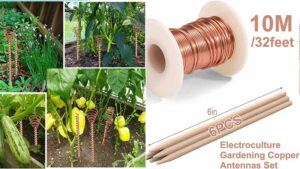
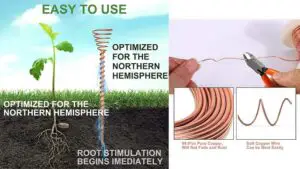
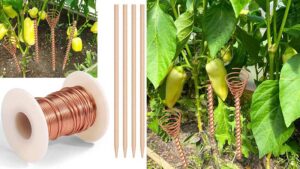
Buy Copper Wire from Amazon Top Rated Seller
About the item
This item is a DIY Electroculture Gardening Kit perfect for making your own electric culture antennas. It comes with 6 stakes and around 33 feet of copper wire. Note: You’ll need to assemble the antenna yourself.
The kit helps reduce the need for fertilizers and pesticides, protecting the environment and saving you money. The copper wire is 16 gauge, offering a great mix of strength and flexibility for effective signal transmission and easy antenna creation.
It’s an ideal gift for garden lovers, fitting all garden sizes and setups. Easy to assemble and use. Plus, the seller offers a full refund if you’re not happy, and you can contact them anytime with questions.
Product Information
| Product Dimension | 3 x 2 x 1 inches |
| Item Weight | 5 ounces |
| Manufacturer | Palksky |
| Country of Origin | China |
| Item model number | Electroculture kit |
| Customer Reviews | 4.6 out of 5 stars |
Buy Copper Wire from Amazon Top Rated Seller
Top reviews from the United States
I had trouble uploading the pictures so I’ll have to describe it best I can. Quinoa seeds weren’t sprouting, so I put the copper wire around the wood stick then buried one end in the soil near the seeds. Two days later I saw sprouts. I think this is worthwhile to explore electroculture on a larger scale for the big garden. With all the chemicals in our soil and air and water, we need all the help we can get to grow healthy plants and food.
Fawn Smith – Accelerates plant growth and strength
Great use for plants that need extra loving.
Jose Calderon – Coil Copper Gadget
The tool and copper wire are easy to use to little decorations for indoor and outdoor plant pots. I didn’t know they are called gardening antenna but they look cool and easy to made with this kits.
LC – Perfect little kit to create decoration for plant pots
Different types of copper wiring available for gardening
Different types of copper wiring are available for gardening, each with unique characteristics and uses.
Here are a few examples:
- Solid copper wire: This type of wire is made from a single strand of copper and is often used for electrical wiring. It can also be used in gardening for applications such as plant supports or trellises.
- Stranded wire: It consists of multiple strands of wiring twisted together. It is more flexible than solid copper wire and can be used for applications such as tying plants to trellises or creating plant supports.
- Coated wire: This is protected with a rust-resistant and corrosion-proof coating, making it ideal for outdoor projects like garden art or sculptures.
- Copper mesh: The copper mesh is a wire woven into a mesh-like pattern. It can be used as a physical barrier to deter pests, as it releases copper ions into the surrounding soil.
- Bare wire: It is uncoated and has no protective coating suitable for grounding electrical systems or creating garden art.
Table 1: Types of Copper Wire and Their Uses in the Garden
| Type of Copper Wire | Description | Garden Use |
| Solid Copper Wire | Single, solid strand of copper | – Plant ties – Simple trellises – Decorative garden twists |
| Stranded Copper Wire | Multiple thin copper strands twisted together | – Flexible structures like hanging ornaments – Temporary plant supports – Wiring for garden lights (if insulated) |
| Thin Gauge Wire (e.g. 26-30 gauge) | Fine, delicate wire | – Jewelry-like plant supports – Detailed garden crafts – Delicate plant ties |
| Thick Gauge Wire (e.g. 8-12 gauge) | Robust, sturdy wire | – Structural supports for heavy plants – Building frames for topiaries – Main structure for trellises and arbors |
| Insulated Copper Wire | Copper wire covered in protective insulation | – Garden lighting circuits – Any electrical application in the garden – Protecting plants from direct metal contact |
Use of copper wiring as a natural pesticide
Gardeners who are environmentally conscious and seek to avoid using harmful chemicals and pesticides can benefit from using them as natural pesticides.
Unlike traditional pesticides, it is non-toxic and does not leave behind harmful residues that can harm the environment or cause harm to animals or humans. It is a safe and effective alternative for sustainably protecting plants from pests and diseases.
Use of copper wiring to improve soil health
Copper is a natural mineral that can help to stimulate plant growth and promote soil fertility.
If you want to optimize the health of your soil, here are a few helpful tips:
- Mix Copper Wire into Soil: It can be cut into small pieces and mixed into the soil to provide a slow release of copper. As the wire decomposes, it releases small amounts of copper into the soil, providing a micronutrient boost for plants.
- Make Copper Water: Copper water can be made by submerging a length of it in a container of water. The water will absorb small amounts of copper over time, which can be used to water plants. Copper water can be used as a natural fungicide to prevent soil-borne diseases and can also help to improve soil structure.
- Compost with Copper Wire: It can be added to compost piles to help speed up decomposition. The copper will help to break down organic matter and release nutrients into the soil. It can also help prevent fungal growth in the compost pile, leading to healthier, more nutrient-rich compost.
- Use Copper Wiring to Test Soil pH: It can test soil pH levels. To do this, bury a small length of the same in the soil and leave it for a few hours. If the copper turns green, it indicates that the soil is alkaline. If the copper turns brown, it indicates that the soil is acidic. This information can be used to adjust soil pH levels for optimal plant growth.
Read this article on Copper Wire to Stop Slugs
Your Garden Diary
Using copper wiring to create a barriers
Using the gardening tool to create barriers effectively protects plants from pests and fungal diseases. Copper is a natural fungicide and insecticide, and its presence can repel slugs, snails, and other harmful pests.
Here are some steps to create a copper wire barrier:
- Choose the Right Gauge: The first step in creating a copper wire barrier is to choose the right gauge of wire. Thicker gauge wires, such as 12 or 14 gauge, are ideal for a long-lasting barrier, while thinner gauges, such as 18 or 20 gauge, can be used for temporary barriers.
- Measure and Cut the Wire: Measure the circumference of the area where you want to create the barrier, and cut the wire to the appropriate length. Make sure to leave a few extra inches to allow for overlapping.
- Install the Barrier: Lay the wire around the plants you want to protect. Overlap the ends of the wire by a few inches to create a complete circle. Secure the ends of the wire together using wire clamps or twist ties.
- Bury the Barrier: Once the wire is installed, bury it about 1-2 inches into the ground. This will help keep the barrier in place and prevent pests from crawling.
- Maintain the Barrier: Check the barrier periodically to ensure it is still in place and hasn’t been damaged. Repair any damage immediately to prevent pests and fungi from entering.
Copper Toxicity Concerns
Copper toxicity is a potential concern in gardening when copper is used in excessive amounts. It occurs when too much copper is in the soil, which can harm plants and other living organisms.
Here are some possible effects of copper toxicity:
- Reduced Plant Growth: High levels of copper in the soil can limit plant growth and development. This is because excess copper can interfere with the uptake of other essential nutrients, such as iron and zinc.
- Soil Contamination: Excessive use of copper can lead to soil contamination. It can remain in the soil for a long time and may not easily break down, leading to accumulation in the soil.
- Toxicity to Microorganisms: It is also toxic to microorganisms, which can lead to a disruption in the soil ecosystem. This can impact the decomposition of organic matter and nutrient cycling.
- Potential Harm to Animals: It can also harm animals that come into contact with contaminated soil. This includes insects, earthworms, and other small organisms that play an important role in the soil ecosystem.
How to handle copper wire safely
Handling the wire safely is important to prevent injury and exposure to potential health hazards. It can be sharp and cause cuts or puncture wounds if improperly handled.
For the greatest safety, here are some useful guidelines for working with copper wiring:
- Wear Protective Gloves: Wear protective gloves to prevent cuts and puncture wounds when handling copper wiring. Thick gloves made of leather or other sturdy materials can help to protect your hands.
- Use Pliers or Wire Cutters: Always use pliers or wire cutters when cutting and bending the wires. This will stop the wire from slipping out of your hands and causing any harm to you in the process.
- Dispose of Scrap Wire Properly: Their scraps can be hazardous if not disposed of properly. To safely dispose of scrap wire, place it in a metal container and label it hazardous waste. Contact your local waste management authority to determine how to dispose of hazardous waste in your area properly.
- Avoid Inhaling Dust or Fumes: Take preventive measures against inhaling the metal dust or fumes produced during cutting and sanding. To ensure your lungs remain safe from any potential hazards, make sure to wear a protective mask at all times
- Wash Your Hands: After handling it, wash your hands thoroughly with soap and water. By using this method, you can eliminate any copper residue and protect your skin from irritation.
Table 2: Lifespan of Copper Wire in Various Garden Conditions
| Garden Condition | Effect on Copper Wire | Estimated Lifespan |
| Direct Sunlight | Slow tarnishing; may develop a patina over time | 20+ years |
| Humidity/Rain | Accelerates tarnishing but enhances natural corrosion resistance | 20+ years |
| Buried Underground | Reduced exposure to elements; minimal tarnishing | 25+ years |
| Coastal (Salty Air) | Accelerated corrosion but generally still long-lasting | 15-20 years |
| Acidic Soil Exposure | Potentially accelerated corrosion depending on soil pH | 15-20 years |
| In Contact with Other Metals (e.g., steel) | Risk of galvanic corrosion if metals are dissimilar | Varies depending on the metals in contact |
How to care for copper wire in the garden
Copper wiring is a natural and effective tool for pest and fungal control in the garden. However, it is important to care for it properly to ensure it remains effective and long-lasting.
Here are some ideas for caring for copper wiring in the garden:
- Clean the Wire: The wire can become dirty and dull over time, reducing effectiveness. To clean it, use a soft cloth or brush to remove any dirt or debris gently. You can also soak it in vinegar and water to help remove any buildup.
- Check for Damage: Regularly check it for damage or signs of wear and tear. If the wire is broken or damaged, replace it immediately to ensure the barrier remains effective.
- Store Properly: When not in use, store it in a dry and cool place to prevent rust and corrosion. You can also wrap the wire in a cloth or paper to prevent tangling and damage.
- Avoid Contact with Chemicals: Certain chemicals, including fertilizers and pesticides, can damage wiring. Avoid applying these chemicals near the wire, and wash the wire thoroughly if it comes into contact with any chemicals.
- Replace When Necessary: It will eventually break down and lose effectiveness over time. If you notice that the wire is no longer repelling pests or fungi, it may be time to replace it with a new wire.
Table 3: Comparison of Copper Wire to Other Garden Wires
| Copper Wire | Steel Wire | Aluminum Wire | Plastic-coated Wire | |
| Conductivity | High | Low | High | Low (insulated) |
| Durability | Long-lasting, corrosion-resistant | Can rust if not galvanized | Can corrode but durable | Depends on inner metal, but coating provides protection |
| Flexibility | Moderate | High (depends on gauge) | High | High |
| Weight | Moderate | Heavy | Light | Varies |
| Aesthetic Appeal | Develops a patina over time | Silver-grey, can darken when exposed | Silver, doesn’t tarnish | Can be various colors, hides metal underneath |
| Cost | Can be pricey | Typically cheaper than copper | Typically cheaper than copper | Varies, usually moderate |
| Other Benefits | Natural slug and snail repellent | Strong, used for heavy-duty tasks | Lightweight, easy to handle | Prevents direct metal-to-plant contact |
Want to learn how to make Electroculture Antennas. Read this article.
Your Garden Diary
Conclusion
To summarize, copper wire is an organic and powerful tool for managing garden pests and fungi. When used judiciously, safely handled, and properly cared for – while also being conscious of potential toxicity – it can be a remarkable aid in sustaining your plants’ health.
If you use it correctly, it will create the ideal conditions that allow your plants to thrive.
People Also Asked Questions
Q: Do plants absorb copper?
A: Yes, plants require copper as one of their essential micronutrients for proper growth and development. However, they can only take up specific forms of copper. While solid copper metal isn’t directly beneficial to plants, when dissolved under acidic conditions, the resulting copper ions are readily taken up by plants.
Q: What plants benefit from copper?
A: Several crops, including beets, carrots, onions, spinach, sunflower, and tomato, have a higher demand for copper and thrive better when adequate copper levels are present in the soil. Similarly, cereal grains can exhibit deficiencies when grown in soils with insufficient copper.
Q: What plants are sensitive to copper?
A: The sensitivity to copper varies among crops. While oats, wheat, and lucerne often respond positively to copper, crops like potatoes and soybeans typically have lower responsiveness. Excessive copper can hinder the growth of plants, with symptoms like reduced root and shoot development. Bean, citrus, and maize plants are particularly susceptible to copper toxicity.
Q: How do you use copper mesh in the garden?
A: The copper mesh is highly versatile and easily shaped to fit various needs. You can form it into rings and place them around plants to protect them. It’s also practical for sealing gaps in greenhouses that might invite slugs. Additionally, you can wrap the mesh around the base of pots (up to 10cm in diameter) to create a protective barrier or “sock.”
Q: Does copper keep insects away?
A: Copper is classified by the EPA as an inorganic pesticide mainly because of its ability to disrupt the functions of enzymes, lipids, and proteins in pests. This property makes copper effective in repelling or mitigating certain pests.
